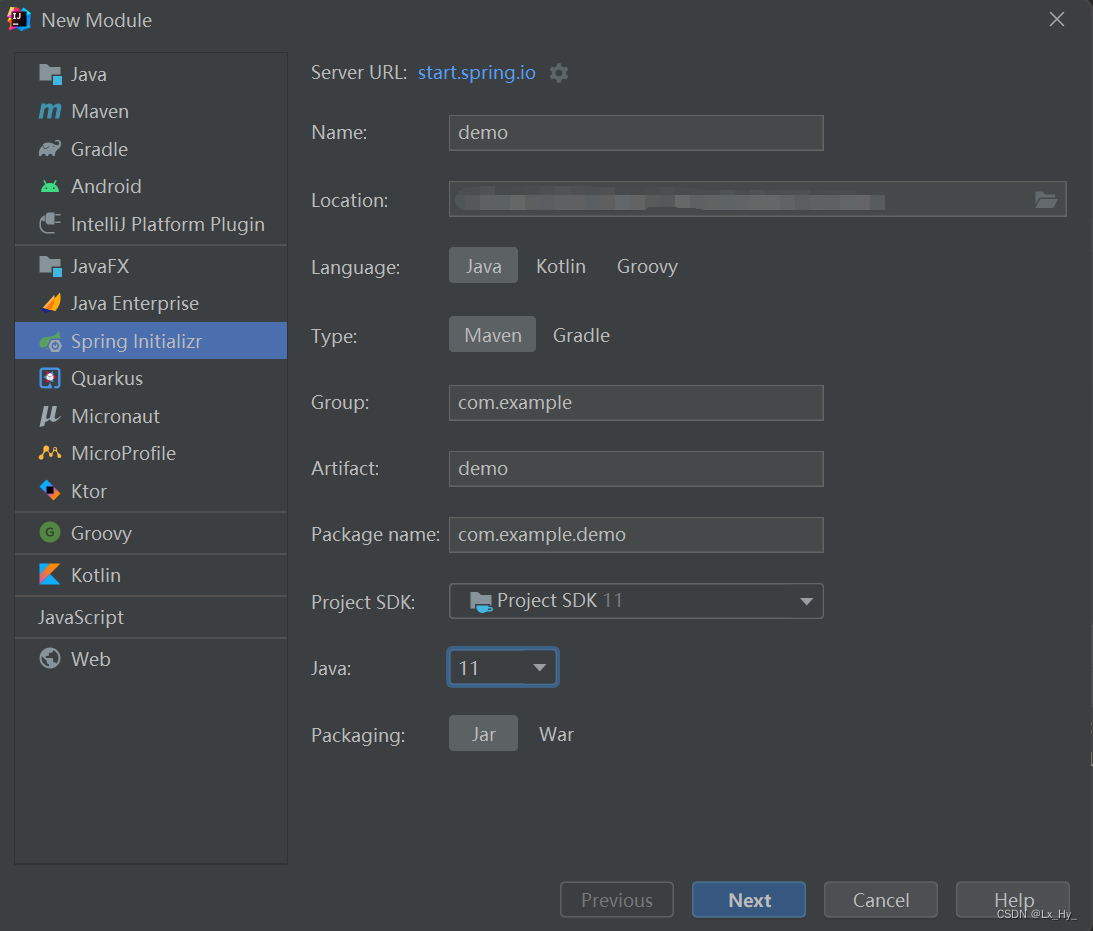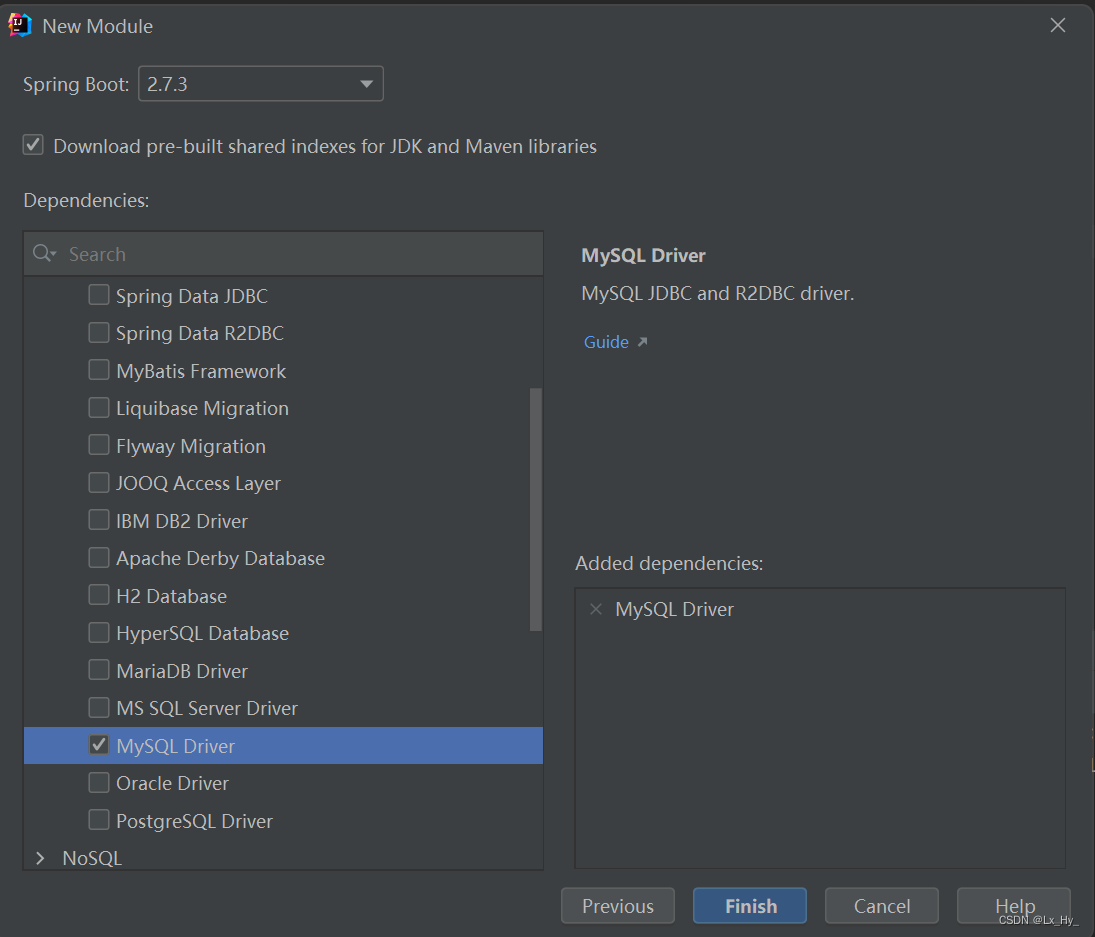目录
【MyBatisPlus】
【概述】
MyBatisPlus(简称MP)是基于MyBatis框架基础上开发的增强型工具,旨在简化开发、提高效率
【官网】
【特性】
- 无侵入:只做增强不做改变,不会对现有工程产生影响
- 强大的 CRUD 操作:内置通用 Mapper,少量配置即可实现单表CRUD 操作
- 支持 Lambda:编写查询条件无需担心字段写错
- 支持主键自动生成
- 内置分页插件
【SpringBoot整合MyBatisPlus】
【使用】
1、创建新模块,选择Spring初始化,并配置模块相关基础信息

2、选择当前模块需要使用的技术(仅保留JDBC)

3、手动添加MyBatisPlus坐标
<dependency>
<groupId>com.baomidou</groupId>
<artifactId>mybatis-plus-boot-starter</artifactId>
<version>3.4.1</version>
</dependency>4、设置Jdbc参数(application.yml)
spring:
datasource:
type: com.alibaba.druid.pool.DruidDataSource
driver-class-name: com.mysql.cj.jdbc.Driver
url: jdbc:mysql://localhost:3306/db1?serverTimzone=UTC
username: root
password: root5、制作实体类与数据源
public class User {
private Long id;
private String name;
private String password;
private Integer age;
private String tel;
}6、定义数据接口,继承BaseMapper<User>
@Mapper
public interface UserDao extends BaseMapper<User> {
}7、测试类注入dao接口,测试功能
@SpringBootTest
class Mybatisplus01DemoApplicationTests {
@Autowired
private UserDao userDao;
@Test
void contextLoads() {
List<User> userList = userDao.selectList(null);
System.out.println(userList);
}
}【标准数据层开发】
【标准数据层CRUD功能】
| 功能 | 自定义接口 | MP接口 |
| 新增 | boolean add(T t) | int insert(T t) |
| 删除 | boolean delete(int id) | int deleteById(Serializable id) |
| 修改 | boolean update(T t) | int updateById(T t) |
| 根据id查询 | T getById(int id) | T selectById(Serializable id) |
| 查询全部 | List<T> getAll( ) | List<T> selectList |
| 分页查询 | PageInfo<T> getAll(int page, int size) | IPage<T> selectPage(IPage<T> page) |
| 按条件查询 | List<T> getAll(Codition condition) | IPage<T> selectPage(Wrapper<T> queryWrapper) |
【Lombok】
Lombok,一个Java类库,提供了一组注解,简化POJO实体类开发(坐标)
<dependency>
<groupId>org.projectlombok</groupId>
<artifactId>lombok</artifactId>
</dependency>或
<dependency>
<groupId>org.projectlombok</groupId>
<artifactId>lombok</artifactId>
<version>1.18.12</version>
<scope>provided</scope>
</dependency>【常用注解】:@Data
@Data
public class User {
private Long id;
private String name;
private String password;
private Integer age;
private String tel;
}【注意】
- 当前实体类在编译期设置对应的get/set方法,无参/无参构造方法,toString方法,hashCode方法,equals方法等
- @Data不包含构造方法
【MP分页查询功能】
1、设置分页拦截器作为Spring管理的bean
@Configuration
public class MpConfig {
@Bean
public MybatisPlusInterceptor mybatisPlusInterceptor() {
//定义Mp拦截器
MybatisPlusInterceptor mybatisPlusInterceptor = new MybatisPlusInterceptor();
//添加具体的拦截器
mybatisPlusInterceptor.addInnerInterceptor(new PaginationInnerInterceptor());
return mybatisPlusInterceptor;
}
}2、执行分页查询
@Test
void testGetByPage(){
IPage page=new Page(1,5);
userDao.selectPage(page,null);
System.out.println("当前页码值"+page.getCurrent());
System.out.println("每页显示数"+page.getSize());
System.out.println("一共多少页"+page.getPages());
System.out.println("一共多少条数据"+page.getTotal());
System.out.println("数据"+page.getRecords());
}【开启日志】
#开启mp的日志(输出到控制台)
mybatis-plus:
configuration:
log-impl: org.apache.ibatis.logging.stdout.StdOutImpl【DQL编程控制】
【条件查询】
MyBatisPlus将书写复杂的SQL查询条件进行了封装,使用编程的形式完成查询条件的组合
【启用条件查询】
QueryWrapper<User> qw = new QueryWrapper<User>();
List<User> userList = userDao.selectList(null);
System.out.println(userList);
【设置条件查询——常规链式格式】
QueryWrapper<User> qw = new QueryWrapper<User>();//查询年龄大于等于18岁,小于65岁的用户
qw.lt("age",65).ge("age",18);
List<User> userList = userDao.selectList(qw);
System.out.println(userList);
【设置条件查询——lambda表达式链式格式——组合查询条件】
LambdaQueryWrapper<User> lqw = new LambdaQueryWrapper<User>();
//10到13之间(and)
lqw.lt(User::getAge, 13).gt(User::getAge, 10);
//小于10,大于13(或者)
lqw.lt(User::getAge, 10).or().gt(User::getAge, 13);
List<User> userList = userDao.selectList(lqw);
System.out.println(userList);【null值处理——条件参数控制】
UserQuery uq=new UserQuery();
//null值判定
LambdaQueryWrapper<User> lqw = new LambdaQueryWrapper<User>();
lqw.lt(null!=uq.getAge2(), User::getAge, uq.getAge2());
lqw.gt(null!=uq.getAge(), User::getAge, uq.getAge());
List<User> userList = userDao.selectList(lqw);
System.out.println(userList);【查询投影】
- 查询结果包含模型类中部分属性
//查询结果包含模型类中部分属性
LambdaQueryWrapper<User> lqw = new LambdaQueryWrapper<User>();
lqw.select(User::getId, User::getName, User::getAge);
List<User> userList = userDao.selectList(lqw);
System.out.println(userList);- 查询结果包含模型中未定义的属性
//查询结果包含模型类中未定义的属性
QueryWrapper<User> qw = new QueryWrapper<User>();
qw.select("count(*) as count,tel");
qw.groupBy("tel");
List<Map<String, Object>> userList = userDao.selectMaps(qw);
System.out.println(userList);【查询条件】
- 范围匹配(> 、 = 、between)
- 模糊匹配(like)
- 空判定(null)
- 包含性匹配(in)
- 分组(group)
- 排序(order)
【eq匹配】
LambdaQueryWrapper<User> lqw = new LambdaQueryWrapper<User>();
//等同于
lqw.eq(User::getName, "lisi").eq(User::getPassword, "123");
User LoginUser = userDao.selectOne(lqw);
System.out.println(LoginUser);【le ge匹配 或 between匹配】
LambdaQueryWrapper<User> lqw = new LambdaQueryWrapper<User>();
//范围查询 lt le gt ge eq between
lqw.between(User::getAge,10,20);
List<User> LoginUser = userDao.selectList(lqw);
System.out.println(LoginUser);【非全文检索:like】
LambdaQueryWrapper<User> lqw = new LambdaQueryWrapper<User>();
//模糊查询
lqw.like(User::getName,"z");
List<User> LoginUser = userDao.selectList(lqw);
System.out.println(LoginUser);【字段映射与表名映射】
1、表字段与编码属性设计不同步
【@TableField】
- 名称:@TableField
- 类型:属性注解
- 作用:设置当前属性对应的数据库表中的字段关系
- 属性:
- value:设置数据库表字段名称
例:
public class User {
@TableField(value="pwd")
private String password;
}
2、编码中添加了数据库中未定义的属性
【@TableField】
- 名称:@TableField
- 类型:属性注解
- 作用:设置当前属性对应的数据库表中的字段关系
- 属性:
- exist:设置属性在数据库表字段中是否存在,默认为true,此属性无法与value合并使用
例:
public class User {
@TableField(exist = false)
private Integer online;
}
3、采用默认查询开放了更多的字段查看权限
【@TableField】
- 名称:@TableField
- 类型:属性注解
- 作用:设置当前属性对应的数据库表中的字段关系
- 属性:
- select:设置属性是否参与查询,此属性与select()映射配置不冲突
例:
public class User {
@TableField(value="pwd",select = false)
private String password;
}
4、表名与编码开发设计不同步
【@TableName】
- 名称:@TableName
- 类型:类注解
- 作用:设置当前类对应与数据库表关系
- 属性:
- value:设置数据库名称
例:
@TableName("tbl_user")
public class User {
private Long id;
}【DML编程控制】
【id生成策略控制】
- 名称:@TableId
- 类型:属性注解
- 位置:模型类中用于表示主键的属性定义上方
- 作用:设置当前类中主键属性的生成策略
- 属性:
- value:设置数据库主键名称
- type:设置主键属性的生成策略,值参照IdType枚举值
例:
public class User {
@TableId(type = IdType.AUTO)
private Long id;
}
【生成策略类型】
- AUTO(0):使用数据库id自增策略控制id生成
- NONE(1):不设置id生成策略
- INPUT(2):用户手工输入id
- ASSIGN_ID(3):雪花算法生成id(可兼容数值型与字符串型)
- ASSIGN_UUID(4):以UUID生成算法作为id生成策略
【id生成策略全局配置】
mybatis-plus:
global-config:
db-config:
id-type: assign_id #自增策略
table-prefix: tb_ #表名的前缀【多记录操作】
- 按照主键删除多条记录
List<Long> ids= Arrays.asList(new Long[]{2,3});
userDao.deleteBatchIds(ids);
- 按照主键查询多条记录
List<Long> ids= Arrays.asList(new Long[]{2,3});
List<User> userList = userDao.selectBatchIds(ids);
【逻辑删除】
【概述】
为数据设置是否可用状态字段,删除时设置状态字段为不可用状态,数据保留在数据库中
【使用】
1、数据库表中添加逻辑删除标记字段(默认值设置为0 )

2、实体类中添加对应字段,并设定当前字段为逻辑删除标记字段
public class User {
private Long id;
//逻辑删除字段
@TableLogic
private Integer deleted;
}【注意】
属性不能为delete
3、配置逻辑删除字面值
mybatis-plus:
global-config:
db-config:
logic-delete-field: deleted
logic-not-delete-value: 0
logic-delete-value: 1
【乐观锁】
【使用】
1、数据库表中添加所标记字段

2、实体类中添加对应字段,并设定当前字段为逻辑删除标记字段
public class User {
private Long id;
//乐观锁
@Version
private Integer version;
}3、配置乐观锁拦截器实现锁机制对应的动态SQL语句拼装
@Configuration
public class MpConfig {
@Bean
public MybatisPlusInterceptor mybatisPlusInterceptor() {
//定义Mp拦截器
MybatisPlusInterceptor mybatisPlusInterceptor = new MybatisPlusInterceptor();
//添加乐观锁拦截器
mybatisPlusInterceptor.addInnerInterceptor(new OptimisticLockerInnerInterceptor());
return mybatisPlusInterceptor;
}
}4、使用乐观锁机制在修改前必须啊先获取到对应数据的version即可正常进行
@Test
void testUpdate() {
//多用户修改
User user = userDao.selectById(3L);
User user2 = userDao.selectById(3L);
user2.setName("zhangsan666");
userDao.updateById(user2);
user.setName("zhangsan888");
userDao.updateById(user);
}执行修改前先执行查询语句
SELECT id,name,age,tel,deleted,version FROM tbl_user WHERE id=? 执行修改时使用version字段作为乐观锁检查依据
UPDATE tbl_user SET name=?, age=?, tel=?, version=? WHERE id=? AND version=? 【快速开发】
【代码生成器】
【模板】
MyBatisPlus提供
数据库相关配置:读取数据库获取信息
开发者自定义配置:手工配置
例:
public class CodeGenerator {
public static void main(String[] args) {
//1.获取代码生成器的对象
AutoGenerator autoGenerator = new AutoGenerator();
//设置数据库相关配置
DataSourceConfig dataSource = new DataSourceConfig();
dataSource.setDriverName("com.mysql.cj.jdbc.Driver");
dataSource.setUrl("jdbc:mysql://localhost:3306/db1?serverTimezone=UTC");
dataSource.setUsername("root");
dataSource.setPassword("root");
autoGenerator.setDataSource(dataSource);
//设置全局配置
GlobalConfig globalConfig = new GlobalConfig();
globalConfig.setOutputDir(System.getProperty("user.dir")+"/mybatisplus_04_generator/src/main/java"); //设置代码生成位置
globalConfig.setOpen(false); //设置生成完毕后是否打开生成代码所在的目录
globalConfig.setAuthor("黑马程序员"); //设置作者
globalConfig.setFileOverride(true); //设置是否覆盖原始生成的文件
globalConfig.setMapperName("%sDao"); //设置数据层接口名,%s为占位符,指代模块名称
globalConfig.setIdType(IdType.ASSIGN_ID); //设置Id生成策略
autoGenerator.setGlobalConfig(globalConfig);
//设置包名相关配置
PackageConfig packageInfo = new PackageConfig();
packageInfo.setParent("com.example"); //设置生成的包名,与代码所在位置不冲突,二者叠加组成完整路径
packageInfo.setEntity("domain"); //设置实体类包名
packageInfo.setMapper("dao"); //设置数据层包名
autoGenerator.setPackageInfo(packageInfo);
//策略设置
StrategyConfig strategyConfig = new StrategyConfig();
strategyConfig.setInclude("mybatisplus_user"); //设置当前参与生成的表名,参数为可变参数
strategyConfig.setTablePrefix("mybatisplus_"); //设置数据库表的前缀名称,模块名 = 数据库表名 - 前缀名 例如: User = tbl_user - tbl_
strategyConfig.setRestControllerStyle(true); //设置是否启用Rest风格
strategyConfig.setVersionFieldName("version"); //设置乐观锁字段名
strategyConfig.setLogicDeleteFieldName("deleted"); //设置逻辑删除字段名
strategyConfig.setEntityLombokModel(true); //设置是否启用lombok
autoGenerator.setStrategy(strategyConfig);
//2.执行生成操作
autoGenerator.execute();
}
}